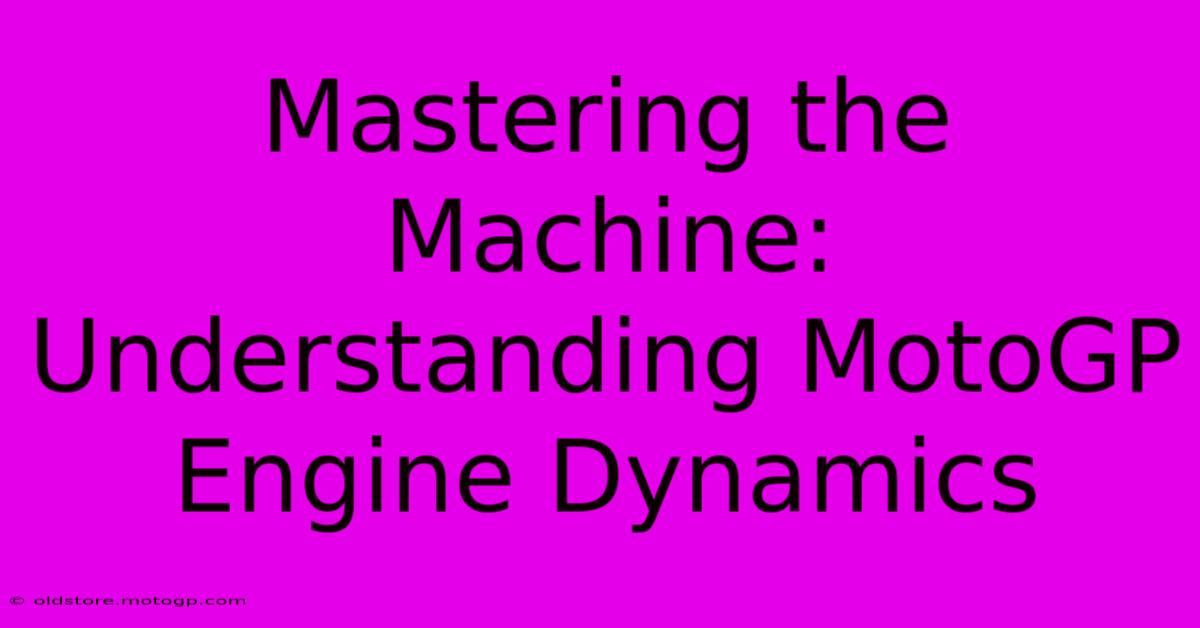Mastering The Machine: Understanding MotoGP Engine Dynamics

Table of Contents
Mastering the Machine: Understanding MotoGP Engine Dynamics
The roar of a MotoGP engine, a symphony of controlled explosions, is a captivating sound for any motorsport fan. But behind that exhilarating noise lies a complex interplay of engineering marvels, pushing the boundaries of what's possible in internal combustion engine technology. This article delves into the fascinating world of MotoGP engine dynamics, exploring the key components and technologies that contribute to these bikes' incredible performance.
The Heart of the Beast: MotoGP Engine Specifications
MotoGP bikes utilize sophisticated four-stroke, 1000cc inline-four engines, representing the pinnacle of motorcycle engine technology. These aren't your everyday engines; they are meticulously engineered for maximum power-to-weight ratio and breathtaking acceleration. Let's break down some key characteristics:
- High RPM Capabilities: These engines routinely rev to over 16,000 RPM, demanding incredibly precise manufacturing and incredibly strong materials to withstand the immense stresses.
- Lightweight Design: Every gram counts in MotoGP. Extensive use of lightweight materials like titanium and magnesium is crucial for achieving optimal performance.
- Sophisticated Fuel Injection: Precise fuel delivery is critical for maximizing power output and efficiency. Sophisticated electronic fuel injection systems constantly monitor and adjust fuel delivery based on various parameters.
- Pneumatic Valve Actuation: Many teams utilize pneumatic valve actuation, offering faster valve timing changes than traditional systems, leading to improved performance at high RPMs.
- Seamless Gearboxes: Quick and precise gear changes are essential for maintaining momentum and lap times. These bikes often feature seamless shift systems, eliminating the interruption of power during gear changes.
Beyond the Basics: Understanding Key Engine Dynamics
The performance of a MotoGP engine isn't just about raw power; it's about managing and harnessing that power effectively. Several key dynamics come into play:
1. Engine Mapping and Tuning:
Engine mapping is the "brain" of the engine, dictating fuel and ignition timing at various RPM and throttle positions. Teams spend countless hours refining engine maps to optimize power delivery throughout the rev range and across various track conditions. This is a crucial aspect of competitiveness.
2. Throttle Response and Control:
Immediate and precise throttle response is critical for precise control, especially during corner entry and exit. Advanced electronic throttle control systems play a pivotal role in achieving this level of responsiveness.
3. Exhaust System Design:
The exhaust system is more than just a pipe; it's an integral part of the engine's performance. Designers carefully optimize the exhaust system's geometry and length to maximize scavenging efficiency, improving engine breathing and power output. The exhaust note itself is a testament to this careful design.
4. Engine Braking:
Engine braking is crucial for controlling the bike's speed during braking and cornering. MotoGP engines are tuned to provide a significant level of engine braking, aiding in stability and control.
The Future of MotoGP Engine Technology
The quest for ever-increasing performance continues. Future developments might include:
- Hybrid Powertrains: The incorporation of hybrid systems to boost power and enhance efficiency is a potential area of future development.
- Improved Materials: The use of even lighter and stronger materials will continue to drive performance gains.
- Advanced Engine Management Systems: Even more sophisticated engine management systems will continue to refine power delivery and optimization.
Mastering the machine in MotoGP isn't just about riding skill; it's a constant evolution in engineering and technology. The engines are a testament to human ingenuity, pushing the boundaries of performance and innovation in the world of motorsports. Understanding the intricate dynamics at play provides a deeper appreciation for the exhilarating spectacle of MotoGP racing.

Thank you for visiting our website wich cover about Mastering The Machine: Understanding MotoGP Engine Dynamics. We hope the information provided has been useful to you. Feel free to contact us if you have any questions or need further assistance. See you next time and dont miss to bookmark.
Featured Posts
-
Cota Open Track Days Get Your Heart Racing
Feb 22, 2025
-
Us Gp Concerts Share Your Experience
Feb 22, 2025
-
Moto Gps Winning Edge The Secrets To Success
Feb 22, 2025
-
F1 Parking Save Time And Money
Feb 22, 2025
-
Exclusive Moto Gp Photos You Cant Find Anywhere Else
Feb 22, 2025
